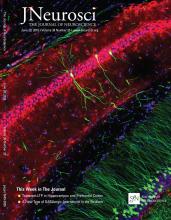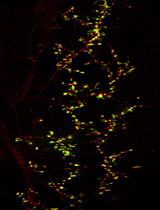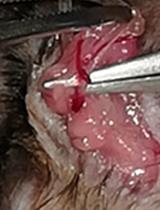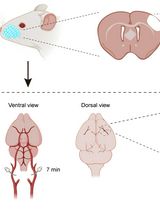- EN - English
- CN - 中文
A Mouse Model of Postoperative Pain
小鼠术后疼痛模型
发布: 2019年01月20日第9卷第2期 DOI: 10.21769/BioProtoc.3140 浏览次数: 8752
评审: Geoffrey C. Y. LauJeremy FerrierAnonymous reviewer(s)
Abstract
Postoperative pain is highly debilitating and hinders recovery. Opioids are the main pain medication used for acute postoperative pain. Given the devastating opioid addiction and overdose epidemic across the US, non-opioid pain therapeutics are desperately needed. In order to develop novel, non-opioid therapies for the treatment of postoperative pain and identify the mechanisms underlying this pain, rodent models of incisional pain have been established. The protocol herein describes in detail how to create a mouse model of postoperative pain that was adapted from established protocols. This model of postoperative pain is frequently-used, highly reproducible, and results in peripheral and central nervous system alterations.
Keywords: Postoperative pain (术后疼痛)Background
Postoperative pain is a significant, worldwide problem. Approximately 234.2 million people undergo major surgeries each year (Weiser et al., 2008) and about 80% of patients experience acute postoperative pain (Gan, 2017). Of these, between 10% and 50% of patients, develop chronic pain that continues to severely impact their quality of life (Chapman and Vierck, 2017). One of the factors that are associated with the development chronic postoperative pain, but unlikely the cause, is the severity of acute pain experienced during the first postoperative week (Fletcher et al., 2015; Chapman and Vierck, 2017). Opioids are the main pain medication used for acute postoperative pain (Sen and Bathini, 2015; Tan et al., 2018). Given the opioid epidemic, non-opioid pain therapeutics are needed. Therefore, identifying the mechanisms that underlie acute postoperative pain is necessary for the development of optimal therapies for postoperative pain that may ultimately decrease the severity and/or incidence of chronic postoperative pain. Both rat (Brennan et al., 1996) and mouse (Pogatzki and Raja, 2003) models of acute incisional pain have been developed as preclinical models to identify the molecular, cellular and physiological mechanisms that underlie postoperative pain. However, a detailed description of the mouse model of postoperative pain is lacking. Here we describe in detail a mouse model of postoperative pain that requires incision of both the skin and muscle. Incision of both skin and muscle best mimics invasive surgery that causes intense acute pain and leads to chronic pain (Brennan, 2011; Chapman and Vierck, 2017). Furthermore, incision of skin and muscle (~6 days) creates hypersensitivity that lasts substantially longer than the skin-only (~3 days) incision model (Xu and Brennan, 2010). In this protocol, we provide detailed, step-by-step methods adapted from previous protocols (Brennan et al., 1996; Pogatzki and Raja, 2003) for development of a mouse model of postoperative pain.
Materials and Reagents
- Stainless steel sterile No. 11 surgical blade (World Precision Instruments, Feather Safety Razor Co. Ltd., catalog number: 504170)
- Sterile 5-0 nylon surgical sutures (AD Surgical, Unify, catalog number: S-N518R13)
- Surgical tape (3M, Transpore, catalog number: 1527-0)
- Cotton swab (VWR, Critical Swab, catalog number: 89031-270)
- Glad Press’n Seal (SAI Infusion Technologies, Glad, catalog number: PSS-70)
- Sterile nitrile gloves (Kimberly-Clark Professional, Kimtech Pure, catalog number: HC61170)
- Petri dishes [VWR, 14.5 and 9 663161, Greiner Bio-One, catalog numbers: 82050-912 (small) and 82050-600 (large)]
- Sterile gauze (Allied Medical, Ardes, catalog number: GA441221)
- Sharpie extra fine point permanent marker (Staples, Sharpie, catalog number: 37001)
- 8-16 week old C57BL/6J mice (JAX, catalog number: 000664)
- Bacitracin zinc ointment (Fougera Pharmaceuticals Inc, catalog number: 0168-0011-04)
- Isoflurane (Clipper distributing company LLC., Phoenix, catalog number: 0010250)
- 75% ethanol (Fisher Scientific, Decon Laboratories, Inc., catalog number: 22-281-562)
- Surgical scrub 7.5% povidone-iodine (Betadine, Veterinary, catalog number: 67618-154-01)
- Eye lube (Patterson Veterinary, Optixcare Ophthalmic, catalog number: 07-893-2779)
Equipment
- 1,000 ml beaker (VWR, PYREX, catalog number: 13912-284)
- #55 Dumostar Forceps (Fine Science Tools, Dumont, catalog number: 11295-51)
- Scalpel handle (Fine Science Tools, catalog number: 10003-12)
- Iris Forceps, 10 cm, Curved, Serrated (World Precision Instruments, catalog number: 15915)
- Halsted Mosquito Hemostatic Forceps, 12.5 cm, Straight (World Precision Instruments, catalog number: 15920-G)
- Vannas Scissors, 8 cm, Curved (World Precision Instruments, catalog number: 14122)
- Small animal surgery board (Braintree Scientific, Inc., CD+, catalog number: ACD 014)
- Isoflurane dispenser (Highland Medical Equipment, Drager, catalog number: 16-7001)
- Sliding top isoflurane induction chamber (Kent Scientific Corporation, catalog number: VetFlo-0530LG)
- Heat Therapy Pump with Pad (Adroit Medical Systems, catalog number: HTP-1500)
- Isothermal pad (Braintree Scientific, Inc., Deltaphase, catalog number: DPIP)
- Digital calipers (VWR, catalog number: 62379-531)
- Steri 250 Bead Sterilizer Bead Bath (Lab Unlimited, Simon Keller Ltd., catalog number: 4AJ-6286283)
- Microwave (Emerson, 1,000 W, catalog number: B007Q45CIS)
- Home cage containing Aspen Sani Chips® (P.J. Murphy Forest and Products, Sani Chips®)
Software
- GraphPad Prism 7
Procedure
文章信息
版权信息
© 2019 The Authors; exclusive licensee Bio-protocol LLC.
如何引用
Readers should cite both the Bio-protocol article and the original research article where this protocol was used:
- Cowie, A. M. and Stucky, C. L. (2019). A Mouse Model of Postoperative Pain. Bio-protocol 9(2): e3140. DOI: 10.21769/BioProtoc.3140.
- Cowie, A. M., Moehring, F., O'Hara, C. and Stucky, C. L. (2018). Optogenetic inhibition of CGRPα sensory neurons reveals their distinct roles in neuropathic and incisional pain. J Neurosci 38(25): 5807-5825.
分类
神经科学 > 感觉和运动系统 > 动物模型
您对这篇实验方法有问题吗?
在此处发布您的问题,我们将邀请本文作者来回答。同时,我们会将您的问题发布到Bio-protocol Exchange,以便寻求社区成员的帮助。
提问指南
+ 问题描述
写下详细的问题描述,包括所有有助于他人回答您问题的信息(例如实验过程、条件和相关图像等)。
Share
Bluesky
X
Copy link













